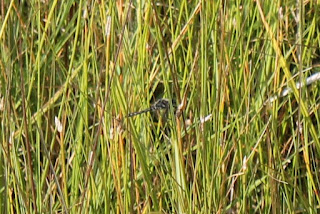James Bay 2018:
Part One
Part Two
Part Three
Part Four
Part Five
Part Six
Part Seven
Part Eight
---------------
August 16, 2018
"Quinten had a VERY busy day. Explored the marsh and found stuff"
That sentence in our daily log pretty much summed up what I dubbed "The Day of the Dragonfly". It was a nice day. Warm and sunny, just like dragonflies like it. It was also quite windy today, which was nice for us humans as it kept the biting insects away. Typically on warm days like that day there'd be biting insects galore, but this day (at least in the morning) there were next to none! Amazingly, over the two week stay, we barely had any problems with insects. I can recall maybe three or four days where we "complained", but even then, it wasn't horrible.
Anyway, dragonflies.
Early on in the day, I spotted a red meadowhawk. Up along the coast, the default red meadowhawk is Cherry-faced Meadowhawk. Since I hadn't netted too many of them before, I decided to take a swing. When I took it out of the net, I was quite happy to see a White-faced Meadowhawk staring back at me!
The latitude of Moosonee more or less represents the northern extent of their known range, so it was quite the exciting find. This is a map from Odonata Central, which is one of the leaders in mapping the distribution of odonates (dragonflies and damselflies) in North America. My record is the northern most green dot.
After that find, I was feeling good so I grabbed my net and went searching in the marsh. I was just thinking about Black Meadowhawks when all of a sudden, an adult male came out of nowhere! I couldn't catch him, but I managed some "record photos". Woohoo!
I saw many more Black Meadowhawks after that. There seemed to be a mass emergence, as many fresh individuals could be found. Pairs in tandem were everywhere, and it seemed every open bit of water has a couple pairs flying over it.
Adult males are very attractive looking.
The biggest surprise of the day came when I took a swing and netted another red type meadowhawk. Before I even took it out of the net, I knew what it was. Saffron-winged Meadowhawk!
I believe there is only one previous record from the James Bay coast, near Attawapiskat, of this species (according to Odonata Central), so I was quite pleased to have found this individual. Although I never saw a female, I think that they are no doubt breeding in the area as the habitat I found it in was spot on for what Saffron-wings like. Just goes to show just how little we really know about what occurs in northern Ontario!
I caught a Cherry-faced Meadowhawk soon after seeing the Saffron-winged, therefore making it a four meadowhawk day. Pretty sweet!
Other than meadowhawks, I saw Sedge Darners, Subarctic Darners, ZigZag Darner, and Lake Darner (all evading capture). I also netted a Sedge Sprite, which again is on the northern end of its range.
 |
| Sedge Sprite |
Of course, we couldn't just fart around all day in the marsh, so we departed in mid-afternoon to head out on our survey. We were doing the Bear Point survey, which meant we were in for a long afternoon and evening. It would be about a seven kilometer walk out from camp, then a seven kilometer walk back. But hey, we knew what we were signing up for!
The walk there was long, partially due to the fact my foot was in quite a bit of pain. Once we arrived at the point where we were to start the survey, I checked and found out why it hurt so much. I had a giant blister on the underside of my toe, and to make it worse, the toe with the blister had rubbed the underside of the neighbouring toe raw! I did my best to bandage it up with what supplies I had. I tried not to let it dampen my spirits!
The survey was pretty average, but highlights included Marbled Godwit, Wilson's Phalarope, Baird's Sandpiper, and Short-billed Dowitcher.
 |
| Black-bellied Plover |
 |
| Baird's Sandpiper |
 |
| Wilson's Phalaropes |
 |
| Short-billed Dowitcher |
It was late by the time we got back, and the mosquitoes were pretty bad (the worst they were pretty much all trip), but hey, at least the scenery was nice.
August 17, 2018
Remember that little foot injury I was talking about? Well, It was bad enough that I stayed back on that day's survey. I spent my time around camp, doing a little bit of birding.
 |
| White-throated Sparrow |
 |
| Red-eyed Vireo |
 |
| Black-and-white Warbler |
 |
| Alder Flycatcher |
I also went down to the creek, dubbed "Stickleback Creek", where we would get our water each day. However, this time instead of bringing jugs, I brought a net. I managed to catch two species of fish, the Northern Pearl Dace, and Brook Stickleback.
 |
| Northern Pearl Dace |
 |
| Brook Stickleback |
It was a pretty relaxing day. I even took a very nice two hour nap :-)
































































